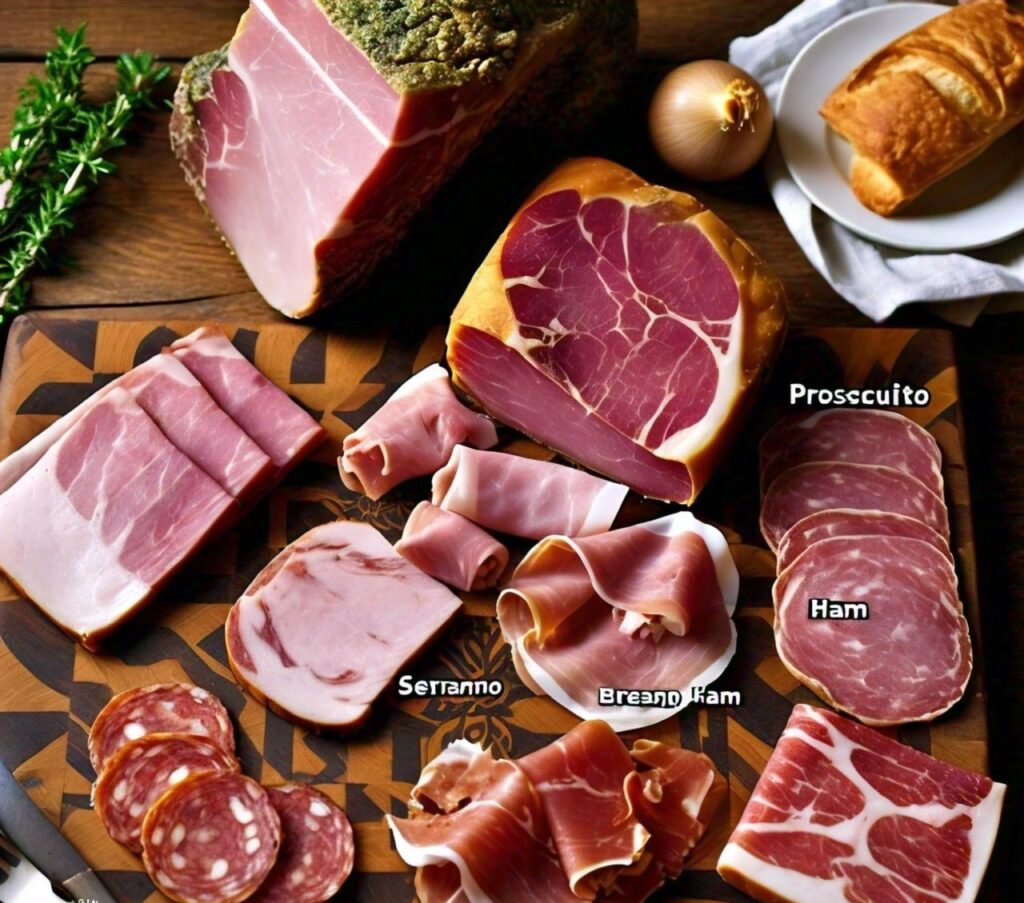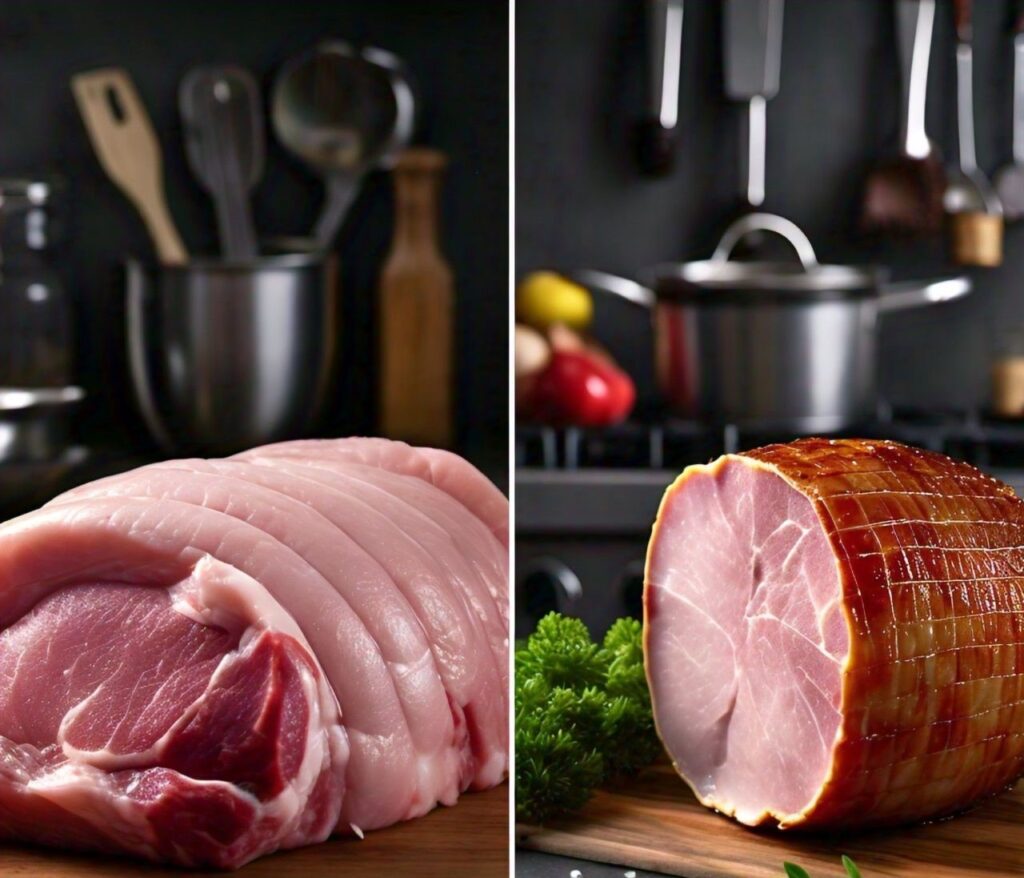Is ham made of pork? This seemingly straightforward yet fascinating question captures the spirit of one of the most beloved treats in the food world. With its savory flavor and soft texture, ham has long been a mainstay in cuisines all over the world, combining history, skill, and culinary creativity tantalizingly. We will go into the history of ham, examine its many varieties and nutritional advantages, and answer frequently asked questions about its intake. Come along on an exploration of the secrets surrounding ham, learning about the diverse range of flavors and cultural connotations entwined with each delicious piece.
History of Ham
Ham has been around for thousands of years. Many ancient cultures valued ham, which is the cured and preserved meat from a pig’s hind leg.
Pork leg curing dates back to 4900 B.C. in China, which has the oldest known records of ham manufacturing.
Afterward, ham curing and preservation became widespread expertise throughout ancient Europe, especially among the Romans and Gauls.
The method of preserving ham by salting, smoking, and oiling it is attributed to the Gauls; other European peoples then embraced and modified this approach.
Throughout the Middle Ages, ham gained popularity as a symbol of luxury and plenty, appearing frequently in literature and art.
Long before the Roman era, the Iberian Peninsula was known for its pigs and hams, making it another early center of ham production.
In many villages, ham gained importance as a trade good alongside goods like wine and olive oil.
What is Ham?
Pork from a pig’s hind leg is called ham. There are several varieties, including country, Black Forest, cured, fresh, and hickory-smoked ham. While boneless hams are sliced and sold for sandwiches, entire hams are made from the pig’s hind leg and have all of the bones left in. Wet brining or dry curing with salt and seasonings are two methods used to preserve ham.
What is Pork?
Pig meat is referred to as pork. It is a popular source of protein that can be utilized in a variety of meals and cuisines due to its versatility in the kitchen. Pork is highly appreciated for its rich flavor and tenderness and can be served in a variety of ways, such as roasting, grilling, frying, or stewing. Pork comes in a variety of cuts and flavors to fit a variety of tastes and recipe needs, from bacon to pork chops to tenderloin.
Types of Ham
Ham comes in various forms, each with its unique characteristics and flavor profiles.
Cured Ham: Wet brining or dry curing are two methods used to preserve cured ham that involve treating it with salt. This technique often yields a rich, savory taste while also enhancing the meat’s flavor and texture.
Fresh Ham: Fresh ham is usually sold uncured and is not preserved like cured ham. It is easy to cook, works well with roasting, grilling, or braising, and has a clear, porky flavor.
Country Ham: Dry-cured with salt and other flavors, country ham is a staple of the South. It is frequently aged for a long time, giving it a hard texture and a strong, deep flavor.
Black Forest Ham: This kind of ham, which comes from the German Black Forest, is smoked over beechwood after being dry-cured, giving it a deep, mahogany color and a characteristic smoky flavor.
Hickory-Smoked Ham: Before being smoked over hickory wood chips, ham is cured with salt and other spices. This method gives the ham a rich, smokey flavor that goes well with many other kinds of food.

Health Benefits
Beyond its nutritional content, ham has certain health advantages. The nutrients in ham promote general health by supporting red blood cell synthesis and promoting muscle building.
Concerns and Controversies
Beyond its nutritional content, ham has certain health advantages. The nutrients in ham promote general health by supporting red blood cell synthesis and promoting muscle building.
Ham vs. Pork: What’s the Difference?
Ham is a pork cut, while pork encompasses various pig meat cuts. Here are some key contrasts:
Preservatives: Pork is usually raw, while ham often contains preservatives like nitrites.
Shelf life: Raw pork needs quick cooking or freezing, while ham can stay in the fridge for days or weeks for dry-cured types.
Flavor: Pork has a mild taste, while ham offers a stronger, smoky flavor.
Cooking with Ham
Due to its versatility in the kitchen, both professional and household cooks prefer using it. There are many ways to use ham in your dishes, whether you want to add some savory flavor to breakfast, lunch, or dinner.
Popular Recipes
It is a basic component of many traditional recipes, such as quiches, omelets, and sandwiches with ham and cheese. Its delicate texture goes well with creamy sauces and heavy casseroles, while its rich taste gives depth to soups, salads, and pasta dishes.
Tips for Cooking with Ham
Take into account the ham’s flavor profile and type when incorporating it into recipes. For recipes where the ham steals the show, like a holiday ham roast, go for a premium, bone-in ham to get the most flavor. Deli ham, cut thinly, is excellent on salads and sandwiches. Furthermore, pay attention to how salty the ham is and modify the spice in your dish accordingly.
Creative Ideas
When cooking with ham, do not be afraid to think beyond the box. Use leftover ham to make a tasty ham and potato hash or add chopped ham to breakfast burritos or frittatas for a high-protein meal. Furthermore, ham can be utilized to lend a gourmet touch to homemade pizzas or to make simple dishes like macaroni and cheese.

For more, read: Chuck Roast
FAQs
Q: What is the difference between ham and bacon?
A: While both ham and bacon come from pigs, they are obtained from different parts of the animal. Ham is typically sourced from the hind leg, while bacon is derived from the pork belly. Additionally, bacon is usually cured and smoked, resulting in its distinctive flavor and texture, whereas ham can be cured or fresh, offering a wider range of culinary applications.
Q: How long does ham last in the fridge?
A: Properly stored, cooked ham can last in the refrigerator for 3 to 4 days. However, for dry-cured hams, such as country ham, the shelf life can extend to several weeks when stored in the refrigerator.
Q: What are some creative ways to use leftover ham?
A: Leftover ham can be utilized in various dishes to add flavor and protein. Some creative ideas include incorporating diced ham into omelets, frittatas, or breakfast burritos, adding it to soups, salads, or pasta dishes for an extra layer of richness, or using it as a topping for homemade pizzas or savory pies.
Q: Can you eat ham cold?
A: Yes, ham can be enjoyed cold, making it a convenient option for sandwiches, salads, and charcuterie boards. However, it can also be reheated and incorporated into warm dishes depending on personal preference and the recipe.
Conclusion
In conclusion, the question “Is ham pork?” serves as a gateway to exploring the intricate world of cured meats and culinary delights. Throughout this comprehensive guide, we’ve peeled back the layers of ham’s rich history, from its origins as a preservation method to its evolution into a cherished ingredient in cuisines worldwide. By examining the various types of ham, uncovering its nutritional benefits, and exploring its diverse culinary uses, we’ve gained a deeper appreciation for this versatile and flavorful meat. So, the next time you ponder the question “Is ham pork?” remember that it not only represents a cut of meat but also embodies centuries of tradition, craftsmanship, and culinary artistry. Embrace the savory journey of ham and relish in its timeless appeal as a staple in kitchens around the globe.

